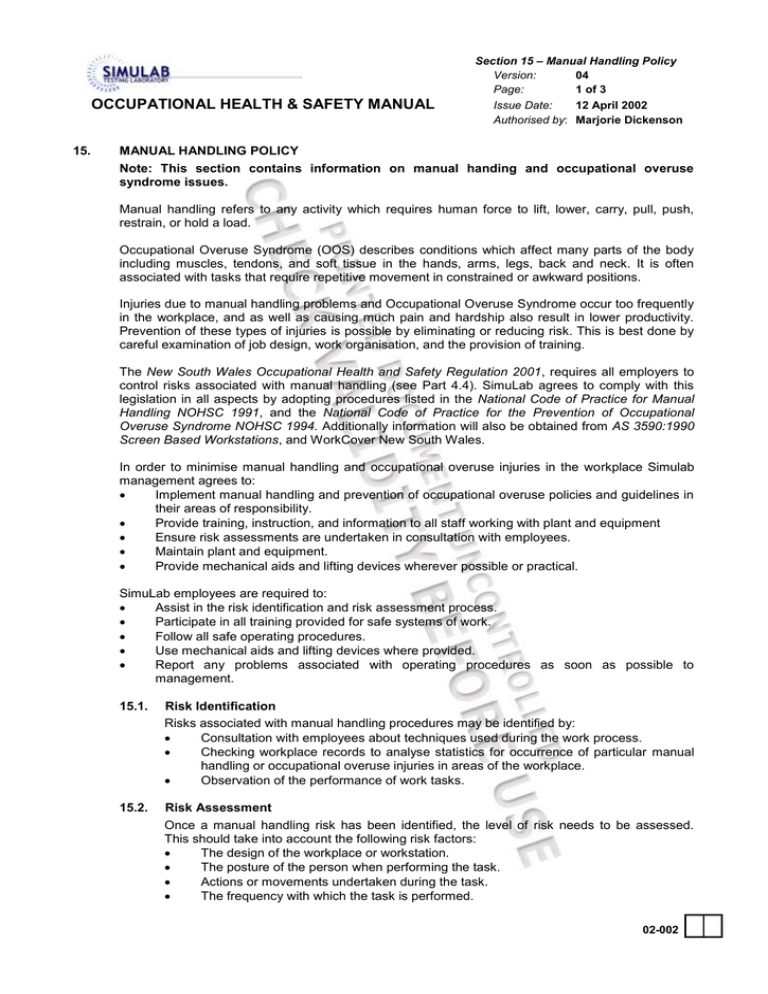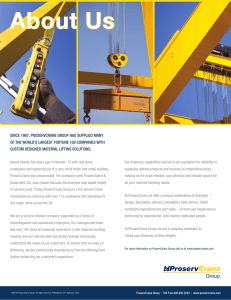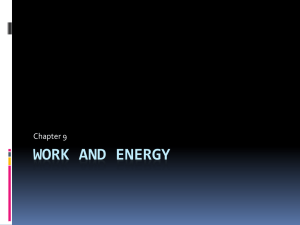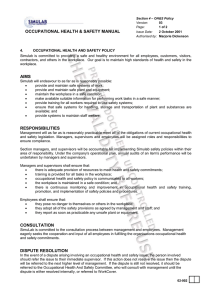OCCUPATIONAL HEALTH & SAFETY MANUAL
advertisement

OCCUPATIONAL HEALTH & SAFETY MANUAL 15. Section 15 – Manual Handling Policy Version: 04 Page: 1 of 3 Issue Date: 12 April 2002 Authorised by: Marjorie Dickenson MANUAL HANDLING POLICY Note: This section contains information on manual handing and occupational overuse syndrome issues. Manual handling refers to any activity which requires human force to lift, lower, carry, pull, push, restrain, or hold a load. Occupational Overuse Syndrome (OOS) describes conditions which affect many parts of the body including muscles, tendons, and soft tissue in the hands, arms, legs, back and neck. It is often associated with tasks that require repetitive movement in constrained or awkward positions. Injuries due to manual handling problems and Occupational Overuse Syndrome occur too frequently in the workplace, and as well as causing much pain and hardship also result in lower productivity. Prevention of these types of injuries is possible by eliminating or reducing risk. This is best done by careful examination of job design, work organisation, and the provision of training. The New South Wales Occupational Health and Safety Regulation 2001, requires all employers to control risks associated with manual handling (see Part 4.4). SimuLab agrees to comply with this legislation in all aspects by adopting procedures listed in the National Code of Practice for Manual Handling NOHSC 1991, and the National Code of Practice for the Prevention of Occupational Overuse Syndrome NOHSC 1994. Additionally information will also be obtained from AS 3590:1990 Screen Based Workstations, and WorkCover New South Wales. In order to minimise manual handling and occupational overuse injuries in the workplace Simulab management agrees to: Implement manual handling and prevention of occupational overuse policies and guidelines in their areas of responsibility. Provide training, instruction, and information to all staff working with plant and equipment Ensure risk assessments are undertaken in consultation with employees. Maintain plant and equipment. Provide mechanical aids and lifting devices wherever possible or practical. SimuLab employees are required to: Assist in the risk identification and risk assessment process. Participate in all training provided for safe systems of work. Follow all safe operating procedures. Use mechanical aids and lifting devices where provided. Report any problems associated with operating procedures as soon as possible to management. 15.1. Risk Identification Risks associated with manual handling procedures may be identified by: Consultation with employees about techniques used during the work process. Checking workplace records to analyse statistics for occurrence of particular manual handling or occupational overuse injuries in areas of the workplace. Observation of the performance of work tasks. 15.2. Risk Assessment Once a manual handling risk has been identified, the level of risk needs to be assessed. This should take into account the following risk factors: The design of the workplace or workstation. The posture of the person when performing the task. Actions or movements undertaken during the task. The frequency with which the task is performed. 02-002 OCCUPATIONAL HEALTH & SAFETY MANUAL Section 15 – Manual Handling Policy Version: 04 Page: 2 of 3 Issue Date: 12 April 2002 Authorised by: Marjorie Dickenson The location of loads and the distances they are moved. The experience of the person undertaking the task. The age of the person undertaking the task. The work environment. Any other factors which might contribute to the risk. As the risks associated with manual handling are many and varied, there is no perfect checklist for risk assessment. The SimuLab Manual Handling Checklist, Form 05-106, should be used in the risk assessment process, but the following process should also be used. Observe the task in a manner which will allow identification of any major risks that will increase the chance of injury. This is best done in a team approach with the supervisor of the person, and a member of the OHS committee as the other parts of the team. For each manual-handling hazard the team should consider: The posture and actions of a person performing the task: o the way in which they bend or twist when lifting loads and how high the load is lifted; o the shape of the objects being lifted or moved; o how often the task is repeated; and o whether the task is performed in a sitting or standing position. The weight of load being moved and the force required to move it - any load that is difficult to pull, push, lift, or slide is a risk. The duration for which the task is performed - any task which is performed for a long time is a risk, especially if it is a repetitive task. The way the work is organised - are tasks varied? Are there pauses in tasks, or deadlines to meet? What is the environment like in which the task is performed? - is lighting adequate? Is there excessive noise? Is the temperature comfortable? Are there any other conditions which make the job difficult? - For example, a slippery floor or poor housekeeping. 15.3. Risk Control The risk associated with manual handling tasks are best controlled or minimised by using the hierarchy of hazard control. The best method of risk control is elimination of the job. For example use mechanical lifting processes instead of manual handling. If the task cannot be eliminated then perhaps the risk can be reduced by job redesigned. This may involve making changes to the workplace or workstation layout, the load, or rearranging the way in which objects are moved in the workplace by using different actions, movements, or forces or even varying tasks. If it is not possible to redesign the job, then the risk may be reduced by the use of mechanical aids. These might include rollers or trolleys, hoists or lifting platforms. It is important that a risk assessment be performed on any mechanical aids which are incorporated into the job process BEFORE they are used. If the job cannot be eliminated, redesigned, or mechanical aids utilised, then administrative controls need to be put in place. Examples of administrative controls include: Provision of staff to enable team lifting. Job or task rotation. Adequate rest breaks and recovery time. Effective maintenance of any lifting equipment used. Provision of personal protective equipment. 02-002 OCCUPATIONAL HEALTH & SAFETY MANUAL 15.4. Section 15 – Manual Handling Policy Version: 04 Page: 3 of 3 Issue Date: 12 April 2002 Authorised by: Marjorie Dickenson Training of personnel in lifting procedures. Lifting Procedures There is no method which can be universally applied to lifting to minimise risk. When considering the most appropriate lifting technique the following approach should be considered. Step 1. Plan the process - This involves knowledge of the strength of the employee and weight of the load. In general employees should seek assistance to lift loads of more than 20 kg under all circumstances. Loads of less than this mass may also require team lifting if they are unusual in shape. Step 2. Choose the best lifting method - lift smoothly with the knees bent and avoid unnecessary twisting or reaching, see Figure 1 below. Step 3. Grip the object securely Step 4. Keep the load close to the body Step 5. Alternate heavy and light lifting - this will allow recovery time for muscles Step 6. Use team lifting where possible Figure 1. It is important that you lift with your knees and not your back. Holding the load as close as possible reduces the force exerted onto your back. 02-002





